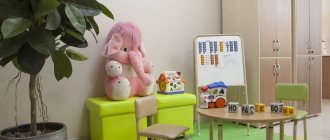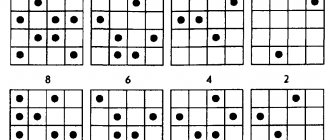Work program for speech therapy classes 1st grade (ZPR)
Meta-subject results.
The course provides the formation of the following universal educational actions:
Regulatory
understand and accept the learning task formulated by the speech therapist teacher;
preserve the educational task of the lesson (reproduce it during the lesson at the request of the speech therapist teacher);
determine ways and means of achieving educational goals;
with the help of a speech therapist teacher, plan an educational task by establishing cause-and-effect sequences;
highlight the main thing in the educational material with the help of a teacher - speech therapist;
exercise control over the progress of one’s activities (from the ability to use samples to the ability to use special self-control techniques);
work at a certain pace;
apply knowledge in new situations.
Cognitive
navigate through textbooks;
understand and interpret conventional signs and symbols used in teaching aids to convey information (conventions, color highlighting);
find and highlight, under the guidance of the teacher, the necessary information from texts and illustrations;
with the help of a speech therapist teacher, analyze objects (words, phrases, sentences) highlighting distinctive features;
compare and classify objects (sounds, words) according to specified criteria;
group objects (sounds, words) based on essential features.
Communication
listen carefully and hear the speech therapist teacher, without switching to extraneous influences;
subordinate your actions to the instructions and comments of the speech therapist;
understand and accept the learning task posed in verbal form;
be fluent in verbal means of communication in order to clearly perceive, retain and concentrate on completing a learning task in accordance with the instructions received;
purposefully (in accordance with the task) carry out educational activities;
follow the rules of speech etiquette when communicating (appeal, request);
explain instructions and learning tasks using the necessary terminology;
turn to an adult or groupmate for clarification;
apply instructions when preparing speech statements in the course and results of educational work;
respond adequately to control and assessment by a speech therapist teacher.
draw up
your thoughts orally (at the level of a sentence or small text);
own
monologue and dialogic forms of speech in accordance with the grammatical and syntactic norms of the native language;
5. CONTENT OF THE CORRECTION COURSE
The training program includes 4 sections:
SECTION 1 - Improving the pronunciation side of speech
1.1
Development of conscious sound analysis and the skill of controlling the pronunciation of sounds found in children’s speech. Formation of the articulatory base.
What parents might be wary of:
- lack of a “revival” reaction to the appearance of an adult;
- the child does not respond to sounds or speech;
- absence or insufficient activity of humming and babbling;
- inactive attempts to repeat other people's words in a child aged 1.5 years;
- a child aged 1.5-2 years does not understand by ear a simple task: “come here”, “sit down”;
- Absence of independent words in a 2-year-old child;
- If a child aged 2.5 years does not have simple phrases of 3-4 words, a vocabulary of less than 20 words, it is difficult to complete the tasks “show the bunny”, “bring the bear”, “drive the car”.
- a 3-year-old child uses gestures and facial expressions more often than speech;
- A 3-year-old child speaks so incomprehensibly that even close people do not understand him.
- lack of own speech at 3 years old (the child repeats only phrases from adults, from books, cartoons, does not initiate speech);
Causes of speech development delay (SDD)
- Intrauterine development disorders (hypoxia, infections)
- Birth asphyxia, birth trauma, prematurity or postmaturity
- Traumatic brain injuries
- Hearing loss
- Frequent and long-term illnesses
- Complications after vaccinations
- Unfavorable environment for speech development. Speech in children appears in response to requests from surrounding adults, as an elementary copy of their speech behavior:
- If there is little conversation with the child, or the environment in which the child develops is inferior (for example, a baby’s home), speech remains unclaimed.
- Overprotection. By anticipating the desires and needs of the child, adults inhibit speech development.
- The child's orientation to the objective world. Parents surround the child with many toys and leave him to play with them for a long time. This helps the baby immerse himself in the inner world.
Article:
Early correction of child developmental characteristics is becoming an increasingly pressing problem in special psychology and pedagogy.
The most important reason for the increase in its relevance is the high percentage of newborns with poor health. Data from special psychology indicate that among various forms of mental anomalies in early ontogenesis, speech disorders are currently the most common. Speech is a subtle psychological process that is formed in the first years of life. The process of speech development is very individual and depends on many factors: social environment, gender of the child, psychological contact with the mother, physiological development, brain functioning, etc. Delayed psycho-speech development in a child is a lag behind the age norm. Such children master speech skills just like other children, but the age range is significantly shifted. Delayed psycho-speech development makes it difficult for a child to communicate with others, prevents the correct formation of cognitive processes, and affects the emotional-volitional sphere. When psycho-speech development is delayed, all types of speech disorders occur, which are also observed in children with normal intelligence. A characteristic feature of the clinical picture of disorders in most children is the complexity of speech pathology, the presence of a complex of speech disorders, and a combination of various speech defects. The majority of children with mental retardation disorders have disorders of both expressive and expressive speech, and inferiority of not only spontaneous, but also reflected speech.
The causes of delayed psychospeech development may be:
- slow rate of maturation of nerve cells responsible for speech (usually due to genetics);
- diseases and lesions of the brain (hypoxia, injuries and infectious diseases suffered in utero, during childbirth and in the first year of life);
- hearing impairment (speech is formed on the basis of what is heard; if a child has hearing problems, then problems arise with reproducing words, that is, with speech);
- early diseases in the first years of life;
- hereditary factors (in these cases, speech impairments may constitute only part of the general disorder of the nervous system and be combined with intellectual and motor impairment);
- unfavorable social and living conditions leading to pedagogical neglect, disturbances in the emotional and volitional sphere and deficits in speech development.
All components of speech activity in young children have their own characteristics: a 4-month-old child does not react emotionally to the gestures of adults and does not smile or perk up when his mother addresses him; A child of 8-9 months has no babbling (repetitive ba-ba-ba, pa-pa-ta, etc. combinations), and at one year old he is an unusually quiet child, making few sounds; the child is already one and a half years old, but he does not speak simple words, for example, “mom” or “give” and does not understand simple words - his name or the names of surrounding objects: he is not able to fulfill the simplest requests like “come here”, “sit down”; the child has difficulty sucking or chewing; at two years old the child uses only a few individual words and does not try to repeat new words; at 2.5 years, the active vocabulary is less than 20 words and phrases; a three-year-old child speaks so incomprehensibly that even his family has difficulty understanding him. He does not speak simple sentences (subject, predicate, object), does not understand simple explanations or stories about events in the past or future; a three-year-old child “rumbles,” that is, speaks too quickly, swallowing the endings of words or, conversely, extremely slowly, stretching them out, although there is no example of such speech at home; at three years old, the child speaks mainly in phrases from cartoons and books, but does not construct his own sentences; a child of any age has a constantly open mouth or increased salivation for no obvious reason (not related to tooth growth); If a child has intact physical hearing and by the age of 3 speaks only a dozen babble words, then in this case the process of speech acquisition is not only delayed in time, but takes on a distorted character.
Attention to the development of a child’s speech in the first stages of development is especially important because at this time the child’s brain is rapidly growing and its functions are being formed. “For speech,” writes Prof. M. M. Koltsova, - such a “critical” period of development is the first three years of a child’s life: by this period the anatomical maturation of the speech areas of the brain basically ends, the child masters the main grammatical forms of his native language, accumulates a large vocabulary. If in the first three years the baby’s speech was not given due attention, then in the future it will take a lot of effort to catch up.”
With psychoverbal underdevelopment of speech, the rate of intellectual development of the child slows down, and therefore mental processes - memory, attention, imagination, thinking, and purposeful behavior - are disrupted. In this regard, speech therapy classes with young children with mental retardation have a number of features:
•Classes with children are based on imitation of an adult, his movements, actions and words, and not on explanation, conversation, or suggestion.
•Elements of training are introduced during the organization of special games.
•It is necessary to achieve emotional contact between the teacher and the child, as well as repeated repetition of verbal material.
Speech therapy work with young children with developmental disabilities is carried out in such areas as the development of impressive and expressive speech, which in turn is divided into two stages. During the first stage of correctional work, the following tasks are solved:
— creation of a communicative environment – i.e. conditions under which the child will have a desire to communicate with the teacher
- education of non-speech and speech attention, development of understanding of speech, one-two-syllable instructions
— overcoming non-verbal and verbal negativism
- evoking the need for verbal expression
— increasing the volume of passive vocabulary
- training parents in proper communication with their child
Forming at the first stage the cognitive prerequisites for the appearance of a speech utterance, special attention is paid to the development of various types of sensations and perceptions (visual, auditory, tactile, gustatory and olfactory). When examining objects with children, the possibilities of visual-motor coordination expand, a relationship is established between visual perception of an object, action with it and its naming. Ideas about the properties of objects (shape, color, size) develop, and the possibilities of phonemic perception expand.
The development of verbal means of communication occurs against the background of expanding cognitive competence. Unobtrusive stimulation of speech in a child is carried out in conditions of providing the child with the opportunity to choose means of communication (non-verbal and verbal). In specific situations, the child’s first one-word and then two-word utterances are called out and encouraged. The work is carried out on the material of lexical topics “Animals”, “Toys”, etc.
The formation and development of children's first practical ideas about sounds and words occurs in play situations. Phonation and physiological breathing develops in children. Articulatory gymnastics is carried out using funny drawings and symbols, which increases children's interest in performing it.
Subtle movements of the fingers are formed and developed. At the same time, it is advisable to carry out hand massage and passive finger exercises. Exercises should be aimed at alternately squeezing, stretching and relaxing the muscles of the hand. The range of movements should increase gradually, without causing discomfort or pain in the child. It is necessary to involve all five fingers of the hand in the process, since each of them has its own efficiency for the development of the motor area of the cerebral cortex and, accordingly, speech activity. Isolated movements of each finger are used.
In the process of various types of children's activities, speech material is consolidated, which causes the greatest difficulties for children. Priority at this stage belongs to substantive activities. The use of practical activities jointly with an adult to stimulate the emergence and development of his need for verbal expression is the leading direction of studies at this stage.
Classes at the second stage of training stimulate the further development of children’s speech abilities. This stage involves solving the following tasks:
— teach the child to repeat after an adult and name sentences independently
- form grammatical forms (number, gender, case).
-learn to use prepositions.
The means for solving these problems are all types of activities characteristic of children from 1 to 3 years old (games, construction, drawing, rhythm, etc.). At this stage, the possibilities of using verbal means of communication expand in the process of a comprehensive examination of objects jointly with an adult. Work continues on the development of visually effective forms of thinking. The priority direction is the development of dialogic speech. A variety of techniques are used: sample dialogues (adult-toy), various types of questions. It is planned to master nouns in the form D.p., T.p. in units and many more number, mastering the category of number of verbs, present and past tense verbs, personal pronouns, some adverbs (more, less), prepositions (in, on). In speech therapy work at this stage, lexical and semantic material of the following topics is used: “Fruits”, “Vegetables”, “Clothing”, “Dishes”, “Pets”, “Wild Animals”, etc.
Speech therapy classes include individual and group sessions lasting from 10 to 25 minutes, depending on the stage of work and the condition of the children. Groups are completed taking into account motor, cognitive and speech development (up to 5 people).
During the period of work on the development of impressive and expressive speech, various methods and techniques of correctional work are used. These are traditional speech therapy methods, such as imitation, speech stimulation, listening, looking, manipulating objects, pictures, object-game activities with toys, drawing, designing, finger games, special mobile and other types of games, massage, gymnastics. Currently, in correctional speech therapy work, along with traditional correctional methods, non-traditional methods of therapy are widely used. Art therapy, music therapy, and chromotherapy are used in working with children with mental retardation disorders. But no matter what methods are used, it is very important to interest the child so that he himself wants to participate in the process of speech correction. And for this purpose, classes should not be boring lessons, but an interesting game.
Thus, success in speech development is possible if a number of conditions are met: emotional contact with the child, a certain level of speech understanding, stability of attention, and the presence of imitative activity on the child’s part. Much will depend on how competently and interestingly the activity with children is organized.
The proposed directions of correctional work with young children with delayed psycho-speech development stimulate the motor, sensory, perceptual speech development of the child, allowing him to gradually, naturally go through the stages of speech development, in accordance with the patterns of speech formation in ontogenesis. I.P. Pavlov said: “Nothing remains motionless, inflexible, but can always be achieved, changed for the better, if only the appropriate conditions are met.”
Literature:
- S., M., B. Overcoming general speech underdevelopment in preschool children: A book for speech therapists. - Ekaterinburg: ARD LTD, 1998.
- E. Speech development: from the first sounds to complex phrases. Educational and methodological manual. - St. Petersburg: Speech; M.: Sfera, 2010.
- Yu. “Steps of development.” Moscow. 1998
- L. “Magic speech therapy.” Donetsk. "Grafi" 2003
- F. “Development of children’s cognitive abilities.” Moscow "AST-PRESS" 2000
How to stimulate speech activity in children with developmental disabilities. Games and exercises
Authors: Irina Gorelova, Anna Ivanova
Speech development delay (SDD) is often accompanied by aggression, anxiety, and difficulties with socialization. The article contains techniques that will help solve these problems and stimulate speech activity in children.
In recent years, children with speech development delay (SDD) have often been admitted to kindergarten. Children easily interact with gadgets, but do not speak. The tablet, phone, TV are not heard, they do not ask questions, they do not stimulate them to look for an answer, and there is no need to tell the child.
Delayed speech development leads to a slowdown in the rate of intellectual development, since memory, attention, perception, thinking, imagination, and purposeful behavior develop with the direct participation of speech. This can slow down and distort the child’s mental development.
Important Remind parents that changes take time and patience, there is no need to force things; If there are no speech changes for a long time, you need to contact a specialist.
Young children need clarity.
The older the child, the less you need to show and the more you encourage him to act on the adult’s word. If a child does not speak or speaks little, you need to offer him entertaining games with objects and pictures.
What to do in the family.
Parents should talk more with the child, encourage them to use words and sentences, provide a sense of psychological security, and an informative and age-appropriate play environment.
Tell parents that before the age of 5, the brain develops rapidly, and this affects the development of speech. Brain development can be helped if the child walks more during daylight hours, does physical exercise, stays in well-ventilated rooms, preferably with pine or citrus scents, changes activities, eats a variety of foods, and does not overwork. It is also important that parents do not smoke in front of the child and that the child does not inhale the smell of cigarette smoke.
Exercise “Brain massage”
Every day, an hour or half an hour before breakfast, the child actively rinses his mouth with boiled water at room temperature for 5 minutes. At the same time, the adult says: “Cheeks wake up, lips wake up, tongue wakes up! Wake up, mind! Wake up speech!”
What to do in kindergarten
To activate children who speak little, you need to offer them tasks that take into account their inclinations and emotions. Educators should include activities in the calendar plan with children telling stories about their favorite toy, etc.
Assignment for the topic “A story about a favorite toy”
The child can draw it or bring it to kindergarten in advance and show it to the children and the teacher. An adult helps with questions: “What is the name of your toy? Can she bark? How angry is she? How happy is he?”
Folders with pictures, albums, books in the group's speech corner should be changed in accordance with the theme of the week. It is better to hang large pictures, as this activates the desire to tell.
On the issue of designing speech therapy support for children with mental retardation
Abstract: The article discusses the features of designing speech therapy classes for children with mental retardation in a preschool educational organization, discusses the forms of speech therapy work, the requirements of the Federal State Educational Standard of Preschool Education for the organization of speech therapy classes with such children, as well as the requirements and structure for these classes.
One of the most important and relevant areas of work with children with mental retardation is the possible correction of child developmental deficiencies, starting from preschool age. Practical experience of speech therapists in preschool correctional educational institutions shows that traditional methods of working with preschoolers are not always effective and appropriate when working with children with mental development disorders. This category of children requires special attention and a special system of work, both in a family environment and in a preschool educational organization.
A preschool educational organization of a combined type ensures the diversified development of children aged 5 to 7 years, taking into account their age and individual characteristics in the main areas of children's development - physical, social-communicative, cognitive, speech and artistic-aesthetic. Among preschool children, there is a group that, in terms of their psychophysical development, lags slightly behind their peers. Until an accurate diagnosis is established, such children are classified as children with special educational needs, namely, the category of children with mental retardation (MDD).
Mental retardation is one of the most common forms of mental pathology in childhood.
The term “delay” emphasizes the temporary and at the same time temporary nature of the lag itself, which is overcome with age. These children are not ready to start school in terms of their knowledge and skills, personal immaturity, and behavior [2, p. 62].
The upbringing and education of children with mental retardation, as well as normally developing preschoolers, is carried out in two forms: in everyday life and in the process of mandatory regular classes. A speech therapist teacher conducts a comprehensive examination of children’s speech, which includes: examination of sound pronunciation, phonemic perception and skills of sound analysis and synthesis, lexical structure of speech, features of word formation, grammatical structure of speech, connected speech.
Despite the fact that the design and implementation of the work of a speech therapist in a preschool educational organization of a combined type is somewhat different from the work of a speech therapist in groups for children with developmental disorders, however, there are common organizational and content aspects.
Speech therapy work with children with mental retardation is carried out in the form of individual (2-3 times a week) and subgroup (2 times a week) classes. The duration of individual lessons is from 10 to 20 minutes, subgroup lessons are from 20 to 25 minutes, according to SanPiN standards. For subgroup (in microgroups) classes, children of the same age group who have similar nature and severity of speech disorders are united, 2–3 people each, the frequency of classes is 2 times a week, 25–30 minutes for children from 6 to 7 years old, 15– 25 minutes for children from 5 to 6 years old.
Corrective work is planned taking into account the individual characteristics of each child with disabilities.
To create a comfortable psycho-emotional regime, correctional and developmental classes are conducted using art-pedagogical technologies [1, p. 54].
When designing correctional classes for children with mental retardation, the speech therapist must take into account the important features of modern preschool education contained in the Federal State Educational Standard for Preschool Education, which differ from traditional education. Preschool educational programs are the diversified development of preschool children, taking into account their age and individual characteristics, including the age of the level of development necessary and sufficient for their successful development of educational programs for an initial individual approach to preschool children and types of activities specific to preschool children. Mastering educational programs of preschool education is not accompanied by certification and final certification of students.
Basic requirements for the development of speech therapy classes in preschool educational institutions for children with mental retardation and speech disorders:
- classes reflect the main tasks of correctional and pedagogical influence on the child’s speech and personality;
- classes are conducted according to the following scheme: sequentially, step by step; taking into account the basic didactic principles and individual characteristics; based on the consciousness and activity of children; using didactic aids and visual teaching aids;
- classes are consistent with the requirements of the educational program;
- During the classes, correct speech is trained;
- classes keep the child in a good mood, cheerfulness, and self-confidence;
- in classes with such children, there are always examples of correct speech from the speech therapist himself, who successfully train the children; tape and audio recordings, etc.;
- classes are conducted against the backdrop of a friendly attitude of others towards a child with speech disorders and his proper upbringing [4, p. 72].
The structure of speech therapy classes in preschool educational institutions with children with mental retardation
The design of a speech therapy lesson in a preschool educational institution with children with mental retardation is based on its structure :
1. Organizational moment . It takes place in the form of preparation for the game (children prepare what they will need during the lesson, under the guidance of adults), they tune in to the game, and do not calm down.
2. Development of visual perception and visual memory. It takes place in the form of a game, the game material is selected taking into account the individual level of development of each child.
3. Development of visual-spatial orientation:
– development of general motor skills. Takes place in the form of a dynamic pause, without interrupting the gameplay, but before or after it, to change types of activities; – development of fine motor skills. You can choose from pentagonal pencils, balls, clothespins, cubes, etc.
4. Development of auditory perception, auditory attention, auditory memory. Provide children with the opportunity to put forward their own assumptions, learn to prove their point of view, form adequate self-esteem, and evaluate their actions, without, for example, identifying one unsuccessful assumption with their own assessment as a whole.
5. Development of articulatory motor skills. It is necessary to explain not only the technique of performing each exercise, but also the meaning, the meaning of each movement of the organs of the articulatory apparatus, so that the child does not just automatically perform all the exercises, but understands why he is doing each specific movement.
6. Development of breathing and voice. During exercises performed to develop breathing, the speech therapist does not show how to perform the exercise, but performs the exercises together with the children.
7. Announcement of the topic. It is not the speech therapist who announces the topic, but the children make assumptions after joint examination, observation, conversation, conversation, experimentation, research, comparison, generalization (the teacher leads them to this), thereby forming motivation to learn new things.
8. Development of phonemic hearing. The course of the lesson is accompanied by significant speech practice of the students, which involves communication with speech therapists and children on equal terms.
9. Work on syllable structure, sound analysis of syllables. It is always accompanied by a visual image, since it is impossible to clearly and correctly reproduce the sound composition of a word without knowing its meaning and without presenting a visual image.
10. Summary of the lesson. Summing up the results of the lesson is focused on the formation of adequate self-esteem, assessment of one’s activities and a positive attitude towards the world.
11. Assessing children’s work in class. What is assessed is not the children’s activity in the lesson, but the extent to which the lesson material helped the children clarify and enrich their knowledge [2, p. 63].
E. S. Teplyakova notes that when designing a correctional speech therapy session that is individually oriented, it is advisable to provide for the following:
- solving the primary task of the speech therapist;
- creating a problematic situation;
- the child’s state of “I want to solve the problem”;
- joint determination of ways to solve the problem, putting forward hypotheses, assumptions from children, the appearance of additional motivation in the child;
- activation of subjective experience, its use in the lesson process (the child’s transition from the position of an object to the position of a subject, encouraging the child’s initiative, supporting his answers in the lesson);
- managing independent search (giving the right to ask someone, consult with parents, older brothers and sisters);
- joint summing up [5, p. 43].
Thus, the design of speech therapy classes for children with mental retardation in preschool educational institutions is carried out taking into account the requirements of the Federal State Educational Standard for preschool educational institutions, the individual characteristics of speech underdevelopment of each child, with a clear idea of the goals (tasks) that can be achieved there, with the help of its most diverse organization, as well as the types and types of this organization.
Literature:
- Kostyuk, A. V. Designing a work program for a teacher-speech therapist at a preschool educational institution: method. recommendations / A. V. Kostyuk. – Ekaterinburg: GAOU DPO SO “IRO”, 2013. – 88 p.
- Lysova, T. S. Model of correctional and developmental support for preschoolers with mental retardation / T. S. Lysova // Continuity in education. – 2013. – No. 5 (11). – pp. 62–65.
- Guide to the Federal State Educational Standard of preschool education in tables and diagrams / edited by. Edited by M. E. Verkhovkina, A. N. Atarova. – St. Petersburg. : KARO, 2014. – 112 p.
- Teplyakova, E. S. Individualization of children’s education in correctional and speech therapy classes / E. S. Teplyakova // Yaroslavl Pedagogical Bulletin. – 2014. – No. 2. – P. 43–48.
Voronina T.V., teacher-speech therapist
- Non-traditional means of speech therapy education for parents raising children with mental retardation
- Recommendations from a defectologist for parents of children of senior preschool age with mental retardation on the prevention of play disorders
- Impaired predicative vocabulary in children with general speech underdevelopment and mental retardation
- Defectological examination of children with mental retardation in a combined kindergarten
- Corrective rhythm as a means of harmonizing the personality of a child with mental retardation
( 1 liked, average score: 5.00 out of 5)
Loading...





